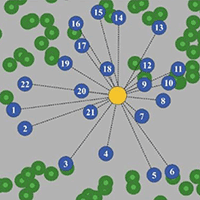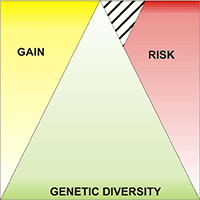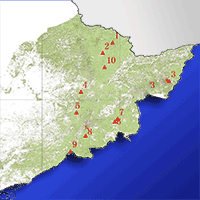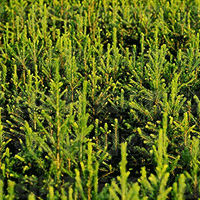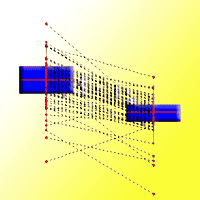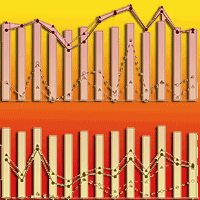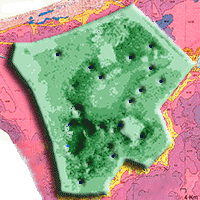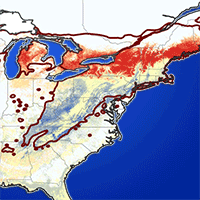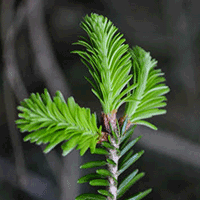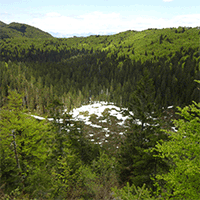Mathematical approaches that explain growth increments, while accounting for inter-tree competition, are advancing. As interactions between trees represent a network structure within an ecological system, they can be described by topological metrics. These metrics may support individual-tree growth modeling in line with ecological processes. Our objective was to compare the performance of traditional indices and complex network metrics in modeling diameter growth. The study area is a semi-deciduous seasonal montane forest in Brazil, where Copaifera langsdorffii was naturally dominant from 2010 to 2017. We selected this species as the subject tree in our study. Tree competitors were identified using the Bitterlich procedure (basal area factor = 4). The periodic annual diameter increment (PAId) was modeled using four strategies, including a genetic algorithm and the random forest method, which involved different competition metrics: distance-dependent, distance-independent, and semi-independent indices, as well as topological metrics from complex networks. We assessed modeling performance based on the analysis of error metrics. The approach developed using topological metrics shows strong potential to explain the PAId through a competition network within an ecological context. The innovative approach used in this study offers robust modeling to support forest growth analysis. Therefore, we encourage the application of this interdisciplinary tool to generate insights into forest science.
Keywords
, , , , ,
Citation
Leite e Lopes I, Sousa da Mata A, Oliveira Castro RV, Viana da Páscoa KJ, Souza Jarochinski e Silva C, Rezende Gomide L (2025). Applying complex network metrics to individual-tree diameter growth modeling. iForest 18: 176-185. - doi: 10.3832/ifor4735-018
Academic Editor
Marco Borghetti
Paper history
Received: Sep 28, 2024
Accepted: Mar 24, 2025
First online: Jul 01, 2025
Publication Date: Aug 31, 2025
Publication Time: 3.30 months
© SISEF - The Italian Society of Silviculture and Forest Ecology 2025
Open Access
This article is distributed under the terms of the Creative Commons Attribution-Non Commercial 4.0 International (https://creativecommons.org/licenses/by-nc/4.0/), which permits unrestricted use, distribution, and reproduction in any medium, provided you give appropriate credit to the original author(s) and the source, provide a link to the Creative Commons license, and indicate if changes were made.

Breakdown by View Type
(Waiting for server response...)
Article Usage
Total Article Views: 3645
(from publication date up to now)
Breakdown by View Type
HTML Page Views: 1240
Abstract Page Views: 1027
PDF Downloads: 1300
Citation/Reference Downloads: 1
XML Downloads: 77
Web Metrics
Days since publication: 189
Overall contacts: 3645
Avg. contacts per week: 135.00
Article Citations
Article citations are based on data periodically collected from the Clarivate Web of Science web site
(last update: Mar 2025)
(No citations were found up to date. Please come back later)
Publication Metrics
by Dimensions ©
Articles citing this article
List of the papers citing this article based on CrossRef Cited-by.
(1)
Aakala T, Fraver S, D’Amato AW, Palik BJ (2013)Influence of competition and age on tree growth in structurally complex old-growth forests in northern Minnesota, USA. Forest Ecology and Management 308: 128-135.
CrossRef |
Gscholar
(2)
Albert R, Barabási AL (2002)Statistical mechanics of complex networks. Reviews of Modern Physics 74: 47-97.
CrossRef |
Gscholar
(3)
Alvares CA, Stape JL, Sentelhas PC, De Moraes Gonçalves JL, Sparovek G (2013)Köppen’s climate classification map for Brazil. Meteorologische Zeitschrift 22: 711-728.
CrossRef |
Gscholar
(4)
Boccaletti S, Latora V, Moreno Y, Chavez M, Hwang D-U (2006)Complex networks: structure and dynamics. Physics Reports 424: 175-308.
CrossRef |
Gscholar
(5)
Boeck A, Dieler J, Biber P, Pretzsch H, Ankerst DP (2014)Predicting tree mortality for European beech in southern Germany using spatially explicit competition indices. Forest Science 60: 613-622.
CrossRef |
Gscholar
(6)
Carrijo JVN, Ferreira ABF, Ferreira MC, Aguiar De MC, Miguel EP, Matricardi EAT, Rezende AV (2020)The growth and production modeling of individual trees of
Eucalyptus urophylla plantations. Journal of Forestry Research 31: 1663-1672.
CrossRef |
Gscholar
(7)
Cerrada M, Sánchez RV, Cabrera D, Zurita G, Li C (2015)Multi-stage feature selection by using genetic algorithms for fault diagnosis in gearboxes based on vibration signal. Sensors 15: 23903-23926.
CrossRef |
Gscholar
(8)
Contreras MA, Affleck D, Chung W (2011)Evaluating tree competition indices as predictors of basal area increment in western Montana forests. Forest Ecology and Management 262: 1939-1949.
CrossRef |
Gscholar
(9)
Corona P, Ferrara A (1989)Individual competition indices for conifer plantations. Agriculture, Ecosystems and Environment 27 (1-4): 429-437.
CrossRef |
Gscholar
(10)
Costa LF, Rodrigues FA, Cristino AS (2008)Complex networks: the key to systems biology. Genetics and Molecular Biology 31: 591-601.
CrossRef |
Gscholar
(11)
Costa MP, Pereira JAA, Benicio MHM, De Sousa H, Fontes MAL, Garcia PO (2012)Allometry and architecture of
Copaifera langsdorffii (Desf.) Kuntze (Fabaceae) in Neotropical physiognomies in southeastern Brazil. Ciência Florestal 22: 223-240.
CrossRef |
Gscholar
(12)
Csardi G (2015)Package “igraph”. The comprehensive R archive network, website.
Online |
Gscholar
(13)
Cunha TA, Finger CAG, Hasenauer H (2016)Tree basal area increment models for
Cedrela, Amburana, Copaifera and
Swietenia growing in the Amazon rain forests. Forest Ecology and Management 365: 174-183.
CrossRef |
Gscholar
(14)
Dale MRT, Fortin M-J (2021)Quantitative analysis of ecological networks (1st edn). Cambridge University Press, Cambridge, UK, pp. 232.
CrossRef |
Gscholar
(15)
Daniels RF, Burkhart HE, Clason TR (1986)A comparison of competition measures for predicting growth of loblolly pine trees. Canadian Journal of Forest Research 16 (6): 1230-1237.
CrossRef |
Gscholar
(16)
Elzhov TV, Mullen KM, Spiess A-N, Maintainer BB (2016)Package “minpack.lm”, v. 1-14. The comprehensive R archive network, website.
Online |
Gscholar
(17)
Gao L, Gao G, Ma D, Xu L (2019)Coreness variation rule and fast updating algorithm for dynamic networks. Symmetry 11: 1-10.
CrossRef |
Gscholar
(18)
Ghanbari R, Jalili M, Yu X (2018)Correlation of cascade failures and centrality measures in complex networks. Future Generation Computer Systems 83: 390-400.
CrossRef |
Gscholar
(19)
Glover GR, Hool JN (1979)A basal area ratio predictor of loblolly pine plantation mortality. Forest Science 25 (2): 275-282.
Online |
Gscholar
(20)
Hegyi F (1974)A simulation model for managing jack-pine stands simulation. Royal College of Forestry, Research Notes 30: 74-90.
Gscholar
(21)
Hong H, Tsangaratos P, Ilia I, Liu J, Zhu AX, Xu C (2018)Applying genetic algorithms to set the optimal combination of forest fire related variables and model forest fire susceptibility based on data mining models. The case of Dayu County, China. Science of the Total Environment 630: 1044-1056.
CrossRef |
Gscholar
(22)
Hui G, Wang Y, Zhang G, Zhao Z, Bai C, Liu W (2018)A novel approach for assessing the neighborhood competition in two different aged forests. Forest Ecology and Management 422: 49-58.
CrossRef |
Gscholar
(23)
Jadhav S, He H, Jenkins K (2018)Information gain directed genetic algorithm wrapper feature selection for credit rating. Applied Soft Computing Journal 69: 541-553.
CrossRef |
Gscholar
(24)
Kuehne C, Weiskittel AR, Waskiewicz J (2019)Comparing performance of contrasting distance-independent and distance-dependent competition metrics in predicting individual tree diameter increment and survival within structurally-heterogeneous, mixed-species forests of Northeastern United States. Forest Ecology and Management 433: 205-216.
CrossRef |
Gscholar
(25)
Kuehne C, Russell MB, Weiskittel AR, Kershaw JA (2020)Comparing strategies for representing individual-tree secondary growth in mixed-species stands in the Acadian Forest region. Forest Ecology and Management. 459: 117823.
CrossRef |
Gscholar
(26)
Latora V, Nicosia V, Russo G (2017)Complex networks: principles, methods and applications. Cambridge University Press, Cambridge, UK, pp. 585.
CrossRef |
Gscholar
(27)
Ledermann T (2010)Evaluating the performance of semi-distance-independent competition indices in predicting the basal area growth of individual trees. Canadian Journal of Forest Research 40: 796-805.
CrossRef |
Gscholar
(28)
Liaw A, Wiener M (2002)Classification and regression by randomForest. R News 2: 18-22.
CrossRef |
Gscholar
(29)
Liu Y, Tang M, Zhou T, Do Y (2016)Identify influential spreaders in complex networks, the role of neighborhood. Physica A: Statistical Mechanics and Its Applications 452: 289-298.
CrossRef |
Gscholar
(30)
Looney CE, D’Amato AW, Fraver S, BJ Palik, Frelich LE (2018)Interspecific competition limits the realized niche of
Fraxinus nigra along a waterlogging gradient. Canadian Journal of Forest Research 48 (11): 1292-1301.
CrossRef |
Gscholar
(31)
Lorimer CG (1983)Tests of age-independent competition indices for individual trees in natural hardwood stands. Forest Ecology and Management 6 (4): 343-360.
CrossRef |
Gscholar
(32)
Lü L, Zhou T, Zhang QM, Stanley HE (2016)The H-index of a network node and its relation to degree and coreness. Nature Communications 7: 1-7.
CrossRef |
Gscholar
(33)
Maglaras LA, Al-Bayatti AH, He Y, Wagner I, Janicke H (2016)Social internet of vehicles for smart cities. Journal of Sensor and Actuator Networks 5: 1-22.
CrossRef |
Gscholar
(34)
Maleki K, Kiviste A, Korjus H (2015)Analysis of individual tree competition effect on diameter growth of silver birch in Estonia. Forest Systems 24: 1-13.
CrossRef |
Gscholar
(35)
Martin GL, Ek AR (1984)A comparison of competition measures and growth models for predicting plantation red pine diameter and height growth. Forest Science 30 (3): 731-743.
Gscholar
(36)
Mata AS (2020)Complex networks: a mini-review. Brazilian Journal of Physics 50: 658-672.
CrossRef |
Gscholar
(37)
Miao S, Zhang X, Han Y, Sun W, Liu C, Yin S (2018)Random Forest algorithm for the relationship between negative air ions and environmental factors in an urban park. Atmosphere 9: 1-13.
CrossRef |
Gscholar
(38)
Mo H, Deng Y (2019)Identifying node importance based on evidence theory in complex networks. Physica A: Statistical Mechanics and Its Applications 529: 121538.
CrossRef |
Gscholar
(39)
Moghadam HE, Mohammadi T, Feghhi Kashani M, Shakeri A (2019)Complex networks analysis in Iran stock market: the application of centrality. Physica A: Statistical Mechanics and Its Applications. 531: 121800.
CrossRef |
Gscholar
(40)
Mongus D, Vilhar U, Skudnik M, Zalik B, Jesenko D (2018)Predictive analytics of tree growth based on complex networks of tree competition. Forest Ecology and Management 425: 164-176.
CrossRef |
Gscholar
(41)
Moore JA, Budelsky CA, Schlesinger RC (1973)A new index representing individual tree competitive status. Canadian Journal of Forest Research 3 (4): 495-500.
Online |
Gscholar
(42)
Moreno PC, Palmas S, Escobedo FJ, Cropper WP, Gezan SA (2017)Individual-tree diameter growth models for mixed
Nothofagus second growth forests in southern Chile. Forests 8: 1-19.
CrossRef |
Gscholar
(43)
Mugasha AG (1989)Evaluation of simple competition indices for the prediction of volume increment of young jack pine and trembling aspen trees. Forest Ecology and Management 26 (3): 227-235.
CrossRef |
Gscholar
(44)
Nakagawa Y, Yokozawa M, Hara T (2016)Complex network analysis reveals novel essential properties of competition among individuals in an even-aged plant population. Ecological Complexity 26: 95-116.
CrossRef |
Gscholar
(45)
Ou Q, Lei X, Shen C (2019)Individual tree diameter growth models of Larch-Spruce-Fir mixed forests based on machine learning algorithms. Forests 10: 1-20.
CrossRef |
Gscholar
(46)
Pedersen RO, Naesset E, Gobakken T, Bollandsås OM (2013)On the evaluation of competition indices - The problem of overlapping samples. Forest Ecology and Management 310: 120-133.
CrossRef |
Gscholar
(47)
R Core Team (2018)R: a language and environment for statistical computing. R Foundation for Statistical Computing, Vienna, Austria.
Online |
Gscholar
(48)
Rezende CL, Scarano FR, Assad ED, Joly CA, Metzger JP, Strassburg BBN, Tabarelli M, Fonseca GA, Mittermeier RA (2018)From hotspot to hopespot: an opportunity for the Brazilian Atlantic Forest. Perspectives in Ecology and Conservation 16: 208-214.
CrossRef |
Gscholar
(49)
Rohlf FJ (1970)Adaptive hierarchical clustering schemes. Systematic Zoology 19: 58-82.
CrossRef |
Gscholar
(50)
Sharma RP, Stefančík I, Vacek Z, Vacek S (2019)Generalized nonlinear mixed-effects individual tree diameter increment models for beech forests in Slovakia. Forests 10: 1-24.
CrossRef |
Gscholar
(51)
Stadt KJ, Huston C, Coates KD, Feng Z, Dale MRT, Lieffers VJ (2007)Evaluation of competition and light estimation indices for predicting diameter growth in mature boreal mixed forests. Annals of Forest Science 64: 477-490.
CrossRef |
Gscholar
(52)
Staebler GR (1951)Growth and spacing in an even-aged stand of Douglas-fir. PhD thesis, School of Natural Resources, University of Michigan, Ann Arbor, MI, USA, pp.57.
Gscholar
(53)
Stage AR (1973)Prognosis model for stand development. Intermountain Forest and Range Experiment Station, USDA Forest Service, Ogden, UT, USA, pp. 40.
Online |
Gscholar
(54)
Sun M, Wang Y, Gao C (2016)Visibility graph network analysis of natural gas price: the case of North American market. Physica A: Statistical Mechanics and Its Applications 462: 1-11.
CrossRef |
Gscholar
(55)
Sun S, Cao QV, Cao T (2018)Evaluation of distance-independent competition indices in predicting tree survival and diameter growth. Canadian Journal of Forest Research 49: 440-446.
CrossRef |
Gscholar
(56)
Tavares Júnior IS, Torres CMME, Leite HG, Castro NLM, Soares CPB, Castro RVO, Farias AA (2020)Machine learning: modeling increment in diameter of individual trees on Atlantic Forest fragments. Ecological Indicators 117: 106685.
CrossRef |
Gscholar
(57)
Tomé M, Burkhart HE (1989)Distance-dependent competition measures for predicting growth of individual trees. Forest Science 35 (3): 816-831.
CrossRef |
Gscholar
(58)
Tsiotas D, Charakopoulos A (2018)Visibility in the topology of complex networks. Physica A: Statistical Mechanics and Its Applications 505: 280-292.
CrossRef |
Gscholar
(59)
Vieira GC, De Mendonça AR, Da Silva GF, Zanetti SS, Da Silva MM, Dos Santos AR (2018)Prognoses of diameter and height of trees of eucalyptus using artificial intelligence. Science of the Total Environment 619-620: 1473-1481.
CrossRef |
Gscholar
(60)
Wang S, Zheng L, Yu D (2017)The improved degree of urban road traffic network: a case study of Xiamen, China. Physica A: Statistical Mechanics and Its Applications 469: 256-264.
CrossRef |
Gscholar
(61)
Zhang Z, Papaik MJ, Wang X, Hao Z, Ye J, Lin F, Yuan Z (2016)The effect of tree size, neighborhood competition and environment on tree growth in an old-growth temperate forest. Journal of Plant Ecology 10: rtw126.
CrossRef |
Gscholar
